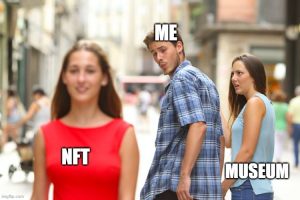Leon Lai
In a 2018 Ted Talk, Amy Whitaker discussed the case of Robert Rauschenberg, who didn’t receive any royalties when an artwork he originally sold for $900 was later re-sold on the secondary market for $85,000. Then Whitaker brings up a new wave term: the Blockchain.
Let’s roughly explain this word in an easy way: the Blockchain can be considered as an art marketplace. The trades are using NFTs—Non-Fungible Tokens—a digital coin like Bitcoin. Artists can sell their artwork in this market and have permanent ownership of reproduction/royalty rights. Every trade in the market is opened and recorded by the system. The only “issue” is that artists need to provide personal information, such as their name, day of birth or their SSN. Also, every time artists post their work into the website—mostly GIFs, JPEGs, or Music—they need to pay some fee first, and then they can sit on the couch to wait for the money coming in their pocket. Since the artist has permanent ownership, they still can have at least 10% of increasing value when the artwork sells on the secondary market. This trade system seems to protect the artists’ benefit and provide a different method from traditional sales.
But is it true?
The system does give lots of the opportunities to artists to sell their artwork and the agency won’t take too much of a cut. Hypothetically, as long as the work keeps selling, the artist can’t be poor forever, because the artist has permanent partial ownership of the artwork. This system definitely helps lots of independent artists. It’s not only decreasing the restriction on artists’ creativity, but also protecting artists from the exploitation of capitalism. In my point of view, I think the NFT can save numerous artists’ lives.
On the other hand, the problem following the system is the value of art. Are the artworks in the market worth a million dollars? “How do you define art?” it’s an old topic. Now that art is no longer a privilege belonging to the nobility, everyone can claim they are an artist—as exemplified by Marcel Duchamp displaying his “notorious” urinal, Fountain in 1917.
Back to the blockchain: every artist in the market has reserved the right to define their work. I looked over OpenSea, the specific website for NFT trading. Some of the designs are good and well done, but most of them are screenshots, memes, or copies of other artists. If an artist should be paid for the effort that he/she put in the project, how to pay for those memes and copies? What is the value of them? I think they should be paid by buyers, but not one million dollars for each. These memes or designs are no more than a symbol of pop culture in a certain era. When the time has passed, they will disappear, or other memes and designs will take their place. In short, most of NFT-traded artworks are just a “hot-take”. People don’t really want to know about art. Buyers are buying this kind of art for investment. It’s a business.
If the original purpose of the NFT-trade is to save independent artists, I think it has been “corrupted”. We can compare this to many precedents of a playful, artistic “vanguard” becoming rapidly commercialized and dumbed-down. The Sundance film festival was basically a summer camp for Hollywood. Recently, many directors who have come out of Sundance have been absorbed by Hollywood industries, such as Ryan Fleck. He directed his breakout Half Nelson in 2006. After a few years, he worked with his wife to produce the inane Captain Marvel for Marvel Studio in 2019.
In the NFT market the artwork here is diverse, for better or for worse, the quality is uneven. I do believe there is a standard out there to estimate the artwork. However, it’s intangible and we can’t really define it. Once we see the artwork, we’ll realize it’s good or bad. For example, if somebody were to tell me Justin Bieber has better acting skills than Brad Pitt, I think the conversation would stop. As I said, the standard is vague, blurred, and undefinable—which is the charisma of art. The various formats and avant-garde spirit are necessary for art, but it doesn’t mean we can do whatever we want and then define it as art. I would like to say NFTs are a good medium for artists, but I question the value of artwork in this market.
